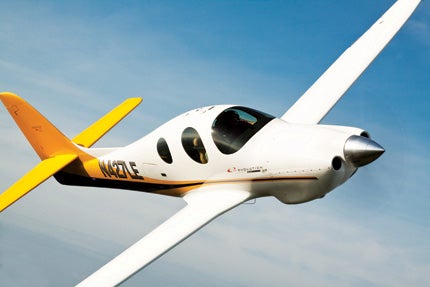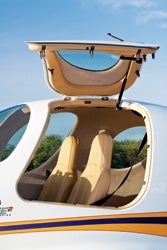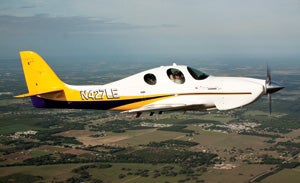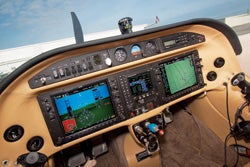 The piston-engine Evolution is powered by a Lycoming TEO-540-AE2A engine and has a max cruise of 270 knots. The carbon-fiber airframe combines light weight with high strength. |
About a decade ago, I was hired to fly an Aerostar 700 from Coeur d’Alene, Idaho, to London, U.K., with Captain Mike Miller, chief pilot for Cathay Pacific Airways. In a sense, the trip was a little uncomfortable for both of us, as my job was to serve as check pilot for Miller, a 20,000-hour 747 captain with time in practically everything—except the Aerostar.
Perhaps perversely, Miller’s insurance company insisted that he fly a few hours with someone who knew a little about the Aerostar, and since I knew as little as anyone, I was nominated. Miller was planning to fly the airplane in the upcoming London to Sydney Air Race, and he needed to relocate the finished Aerostar from Idaho to the U.K. The airline captain was absolutely positive he could win the big prize in the 16-leg, 12,000 nm race. (He did exactly that, averaging 274 knots.)
During our three-day, 5,200 nm trip across North America and the Atlantic, we luxuriated in the airplane’s near-turboprop cruise speeds en route to Biggin Hill Airport, starting point for the event. On each leg, we launched and climbed straight to 25,000 feet, maintained power at max cruise and saw consistent true airspeeds of 260 knots or better. One leg—Narsarsuaq, Greenland to Reykjavik, Iceland—yielded a spectacular 330-knot groundspeed.
Despite (or perhaps because of) his jet experience, Miller commented that this was pretty impressive for an airplane flying behind piston power. In fact, there has never been another production piston airplane capable of generating such speed, regardless of horsepower. Back in the ’60s, the Piper Comanche 400 employed a huge eight-cylinder Lycoming IO-720, essentially a pair of IO-360s welded together, but without a blower under the bonnet, that airplane was limited to 200 knots.
The current turbocharged, intercooled Mooney Acclaim S manages to score 242 knots on only 280 hp, but that’s as close as anyone has come to marketing another production, 260-knot piston machine.
 |
Enter The Evolution
Now, Lancair International of Redmond, Ore., plans to certify an airplane capable of topping the Aerostar’s quick cruise, and with only one piston engine out front. Some astute readers may remember that the turbine version of the Lancair Evolution was introduced two years ago (see “Lancair Evolution: Revolutionary Homebuilt,” Pilot Journal Spring 2009). At this writing, both the turboprop and piston models are offered as homebuilts, but Lancair is actively pursuing certification on both airplanes.
Of course, there’s the inevitable question: Why build two versions of the same airplane? The two models are identical from the firewall aft. Lancair COO Tom Bowen explains: “The most obvious reason is price. The basic Evolution airframe package costs $495,000 to build, excluding paint, interior and a few other items. Then, you have a choice between a $115,000 Lycoming piston engine or a $445,000 Pratt & Whitney turbine mill. Add $32,000 for the prop and $84,000 for all hoses, baffling, engine exhaust, tubing, wiring and hardware, and the cost for a fully completed, painted Evolution with a leather interior will be approximately $750,000 for the piston model, $1,150,000 for the turboprop. Hourly operating costs also should be dramatically less costly with the avgas model, for those who don’t feel a need for high altitude and 300-plus-knot speed on every flight.
“Finally, and probably the best reason of all,” Bowen continues, “our customers asked for it. We surveyed many of our Lancair IV customers, and the feeling was almost unanimous that there’d be a major market for a piston version.”
 |
Primed For Certification
The new Evolution was intended specifically for certification, so the airplane was designed to comply with all the standard parameters and flight tests required for Part 23 approval. The vision for the project came from Lancair owner and CEO Joe Bartels, who knew that standing by tradition means letting everyone else pass you by. Bartels knew his company needed a new product for the 21st century. The Lancair IV’s performance was spectacular, but that airplane was designed in the late 1980s. Bartels felt it was time for something new.
The Evolution is most emphatically “something new.” From spinner to tailcone, the design literally shouts speed and efficiency. The semicircular, swept, carbon-fiber fuselage also suggests pressurization, and that’s another important part of the design. This airplane specifically targets speed and comfort.
A 21st Century Design
By any measure, the Evolution’s carbon-fiber fuselage is an ecstatic shape, as smooth as Murano glass. The airplane looks like something Luke Skywalker would fly, full of consonant lines and completed ideas, like a good piece of music. The wing is a beautiful, quarter-elliptical design, an arcing, graceful planform unlike anything most pilots have seen before. In fact, it’s actually a combination of four distinct airfoils configured by aerodynamicist Greg Cole of Windward Aviation in Bend, Ore.
Cole’s credentials include a master’s degree in aerospace engineering from Notre Dame, plus design work at McCauley Propeller Systems, where prop designs nearly always incorporate multiple airfoils. In addition, Cole has participated in a variety of sailplane and other experimental aircraft projects. The engineer has been working with Lancair on development of everything from the two-seat Legacy to the Columbia 300/350 (back when the companies were combined—the airplane is now known as the Cessna Corvalis). Cole is considered especially adept at designing airfoils with low Reynolds numbers (read “laminar flow wings”).
 |
Project Manager
Lancair General Manager Tim Ong was the ramrod on the Evolution project, and Ong deserves the lion’s share of credit for keeping the Evolution on track and driving it through to completion. According to Bowen, Ong is an expert designer and outstanding airframe stress engineer. Part of his job was weight reduction, generally regarded as the toughest mission in aviation, whether you’re building an airliner or an LSA. By a combination of black magic and collusion with the devil, Ong maintained the Evolution’s basic empty weight at 2,500 pounds against a gross weight of 4,300 pounds. With a standard 144 gallons of fuel on board, this means the basic payload remains well over 900 pounds.
 |
Evolution Vs. IVP
It’s inevitable that the Evolution will be compared to the Lancair IVP, the company’s premier homebuilt product, but there’s very little similarity between the two airplanes other than carbon-fiber construction, side sticks and the nameplate.
In fact, the Evolution is an all-new, clean-sheet airplane deliberately intended to correct those features of the Lancair IVP that some owner/builders suggested needed revision. The Evolution’s pressurization system pumps up the cabin to a 6.0 psi differential compared to 5.0 psi on the IVP. The new model offers a 6,000-foot cabin at 25,000 feet and 8,500-foot atmosphere at the airplane’s 28,000-foot maximum approved altitude. Another benefit of the Evolution is that the baggage compartment is an integral part of the pressure vessel, so anything you store there will enjoy the same low-altitude benefits that you do. (In other words, no more exploding toothpaste.)
The Evolution’s fuselage is four inches wider and taller than the Lancair IVP’s cabin, a cylinder roughly 50 inches in diameter. Optimum build time on the Evolution is only 1,200 hours compared to a typical 3,500 to 4,000 hours for the IVP. Payload is 350 to 400 pounds more generous on the Evolution than on the IVP. Finally, the Evolution has conventional flight characteristics, whereas the IVP is a fully optimized experimental airplane, designed specifically for maximum speed, and that translates directly to a higher stall speed and higher approach speeds.
Twenty years ago, when I flew the Lancair IV for the first time with designer Lance Neibauer, I asked him what would be required to certify the IV. He laughed and commented, “There’s absolutely no way you could ever certify the Lancair IV. I designed it specifically as a high-performance homebuilt with speed as the primary goal. It’s not a dangerous airplane to fly, but the wing is optimized for cruise, and that means the stall is far too quick for certification.”
 |
Power To The Pilot
Power for the avgas Evolution is provided by a modified version of the 540-cubic-inch Lycoming. The engine is an electronically controlled version of the same mill used in the Piper Mirage. Technically, its designation is TEO-540-AE2A, and it’s the first of Lycoming’s new computer- controlled iE2 engines. iE stands for integrated electronics, and the system relieves the pilot of practically all engine management responsibilities. Despite the powerplant’s size and complexity, operation is as simple as “push forward to go, pull back to stop.” The pilot need only decide how fast to fly and how much fuel to burn. The computer automatically monitors the EGT and CHT of each cylinder and adjusts mixture to optimize performance.
The airplane I flew was the prototype, so it wasn’t in final configuration. It featured a prop control (that we never touched), but the production version will utilize a single-lever power control.
The engine will be rated for a max 400 hp for climb and 350 hp continuous. Tom Bowen says he expects Lycoming to certify the engine for five minutes at the 400 hp rating before reducing to METO power. Though the TEO-540 is fully electronically controlled, it’s not referred to as FADEC, as it does incorporate a mechanical throttle linkage. The Lycoming even includes an automatic run-up feature that checks all systems and advises the pilot if everything is within tolerances. Lycoming should have completed its final certification tests by the time you read this, and the finished Evolution should be available for purchase as a homebuilt about Oshkosh time.
 |
A Study In Performance
Flying the Evolution is a different experience than aviating in the Lancair IVP. I’ve flown the IVP a half-dozen times, and I analogize it to flying a WWII fighter with three good friends along for the ride. The numbers are spectacular, handling is generally good and the airplane is reasonably comfortable, but I understand why some pilots regard its flight characteristics as a little too aggressive. Though the stall is only three knots above the FAA’s certified limit, stall characteristics are more abrupt, and recovery demands more altitude. If you’re looking for ultimate performance, the Lancair IVP is a great choice. If you’re seeking a more benign personality with still impressive climb and cruise numbers, Lancair hopes you’ll choose the Evolution.
Despite the massive injection of horsepower, the big Lycoming doesn’t exactly foam at the mouth. Still, there’s little question you’re going someplace when you put the big knob against the panel. You can plan on an easy 2,000 fpm initial climb under gross conditions, perhaps 2,500 fpm at light weights. Combine strong climb with the airplane’s stout pressurization system, and there’s little reason not to fly virtually any trip in the mid to high teens, where you’ll see an easy 220 to 230 KTAS. Ascend to the medium flight levels—the Evolution is approved for flight at FL280, the maximum non-RVSM height—and you should see the magic 270 knots. With a stall at only 61 knots, this means the Evolution enjoys a flight-envelope speed ratio of 4.4 to one.
Tom Bowen flew the prototype down from Oregon to the Sun ‘n Fun show in Lakeland, Fla., at 25,000 feet, and he saw a consistent 250 knots on 23 gph. Most weather tops at 15,000 feet or below, so you can plan on cruising in smooth air and sunshine 90% of the time, even if you only opt for the highest non-IFR altitude, 17,500 feet.
My first takeoff in the Evolution was a formation departure out of Plant City, Fla., on the wing of a 172, and it wasn’t a problem. The lead pilot kept the Skyhawk low after liftoff, and the Evolution maintained an easy 20- to 30-foot separation as we climbed out for Jim Lawrence’s camera. With one door off, the Skyhawk probably couldn’t manage more than 100 knots, but the Evolution didn’t seem to mind in the least.
Stalls in the newest Lancair are pretty much an anticlimax. The break is straight ahead, with little tendency to drop a wing. I tried stalls in a variety of configurations, and the airplane refused to do anything unusual.
Such gentle manners in down and dirty trim suggest good landing characteristics, and the Evolution doesn’t appear to have any bad habits. Stall speed is a docile 61 knots. Using 85 knots around the pattern and as little as 75 knots across the fence (roughly the same numbers you’d use in the old Columbias), the Evolution can easily handle 2,000-foot strips. Judging the flare is simple, and the Evolution’s trailing-beam landing gear eases the actual touchdown.
So far, only about a dozen Lancair Evolutions have been built, and those have all been turbine models. It may not be long before piston Evolutions begin construction at the company’s Oregon plant.
Make no mistake, these aren’t your typical homebuilts, but you can be guaranteed they’ll fly higher and faster than pretty much anything else in the piston world. Mike Miller would be proud.



